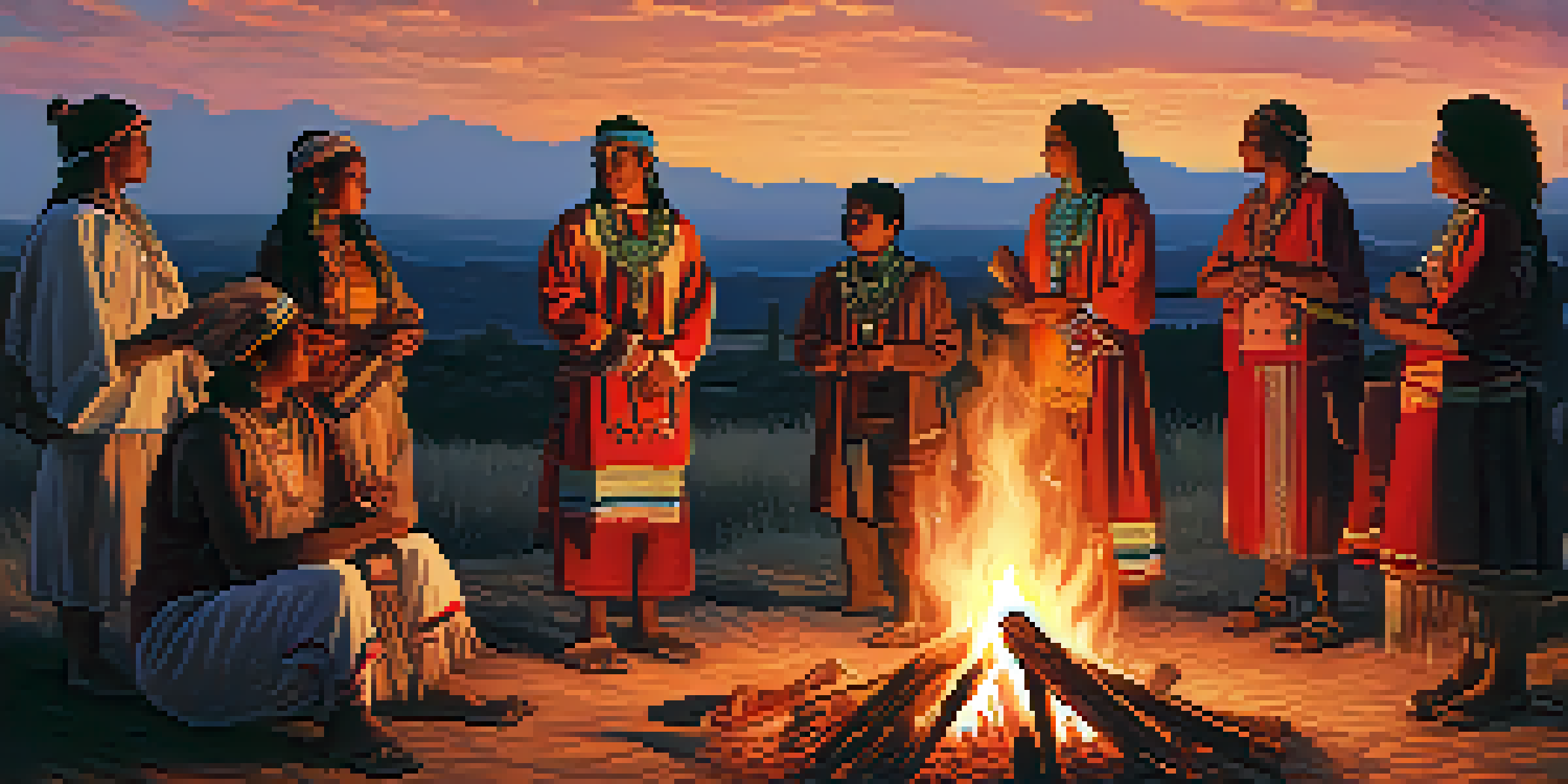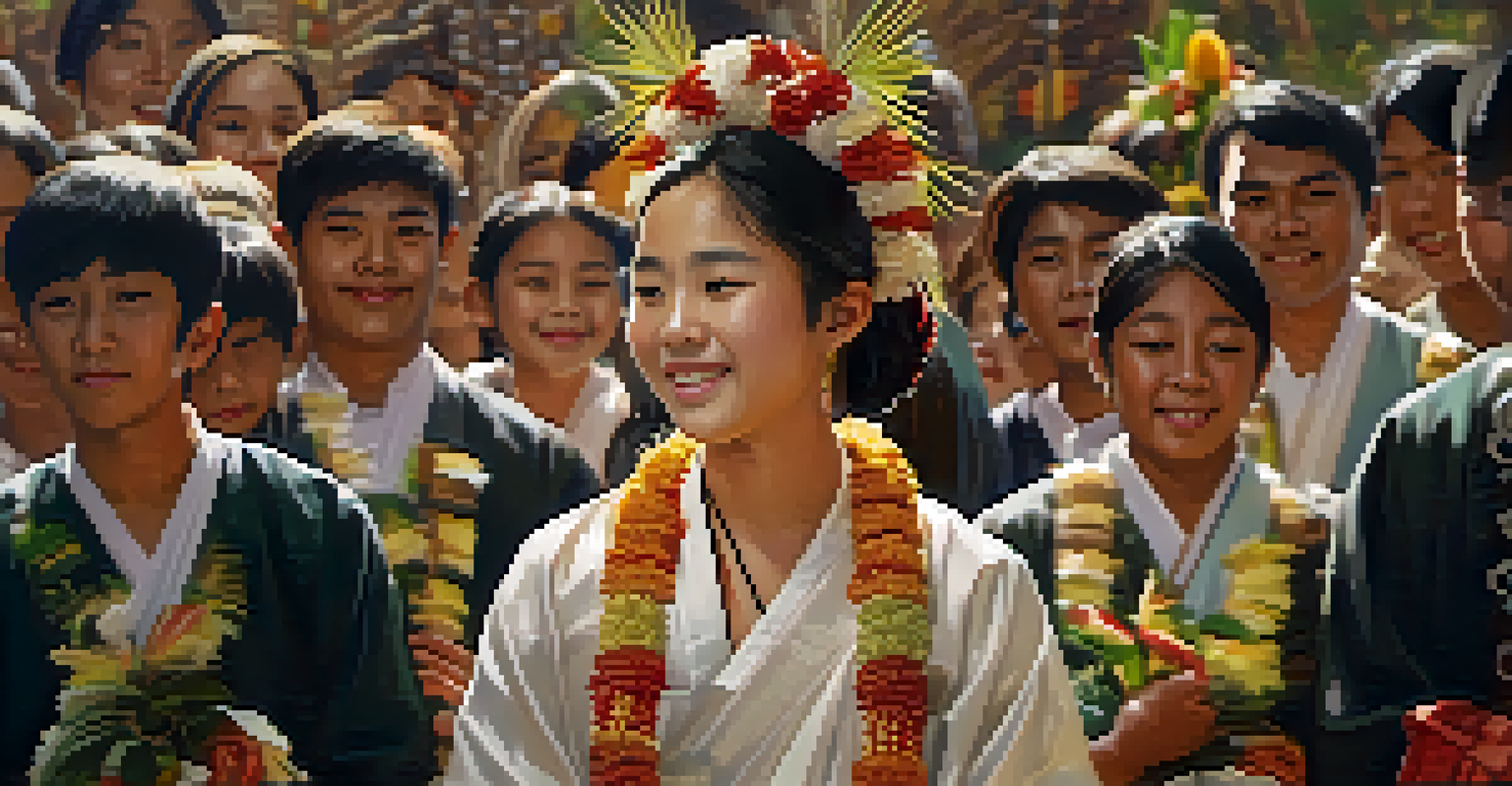How Spiritual Practices Shape Cultural Identity Across Generations

Understanding Spiritual Practices and Cultural Identity
Spiritual practices are often deeply intertwined with cultural identity, shaping how communities define themselves. These practices can range from rituals and ceremonies to daily habits that reflect a group's beliefs and values. When we talk about cultural identity, we're referring to the shared characteristics—like language, traditions, and customs—that help a group of people feel connected.
Tradition is not the worship of ashes, but the preservation of fire.
For instance, consider how Indigenous communities incorporate spiritual practices into their cultural identity through storytelling and rituals. These practices not only preserve their history but also reinforce a sense of belonging among community members. As younger generations engage with these traditions, they often find a deeper connection to their ancestors and heritage.
This relationship between spirituality and culture highlights the importance of passing down practices through generations. By doing so, communities maintain their unique identities while fostering a sense of continuity and resilience, even amidst change.
The Role of Rituals in Transmitting Values
Rituals serve as a powerful tool in passing down cultural values from one generation to the next. They create a structured way for families and communities to come together and engage in shared experiences, reinforcing their beliefs. For example, a coming-of-age ceremony can mark a young person's transition into adulthood, highlighting the expectations and responsibilities that come with it.

Through these rituals, participants often gain insights into their cultural heritage, learning the significance of their practices and the values they embody. This transmission of knowledge helps younger generations understand their place in the world, fostering a sense of purpose and belonging. When a family gathers for a holiday celebration, they don't just enjoy a meal; they also partake in a rich tapestry of stories, lessons, and traditions.
Spirituality Shapes Cultural Identity
Spiritual practices deeply intertwine with cultural identity, helping communities preserve their beliefs and foster a sense of belonging.
Moreover, the emotional weight of these rituals can create lasting memories that resonate throughout a person's life. As individuals reflect on these experiences, they carry forward the lessons learned, ensuring that the cultural identity remains vibrant and relevant.
How Spiritual Practices Adapt Over Time
As cultures evolve, so too do their spiritual practices, which often adapt to contemporary contexts while maintaining core values. This evolution can be seen in how traditional ceremonies incorporate modern elements, making them more relatable to younger generations. For example, the way a family celebrates a religious holiday may blend traditional rituals with new customs that reflect current lifestyles.
The greatest gift of the garden is the restoration of the five senses.
This adaptability allows spiritual practices to remain relevant, ensuring that they resonate with people of all ages. When individuals see their beliefs reflected in their daily lives, they are more likely to embrace and continue those practices. This is particularly important in multicultural societies, where diverse influences can enrich spiritual expressions.
However, the challenge lies in balancing tradition with innovation. Communities must navigate the fine line between honoring their heritage and embracing new ideas, all while striving to keep their cultural identity alive for future generations.
Intergenerational Connections Through Spirituality
Spiritual practices often serve as a bridge between generations, fostering connections that transcend time. When grandparents share their spiritual journeys with grandchildren, they create a space for dialogue that deepens family ties. These conversations can lead to a richer understanding of both the past and the present, allowing younger family members to appreciate the wisdom of their elders.
For instance, storytelling becomes a powerful medium for sharing spiritual teachings and life lessons. A grandparent might share tales from their youth that highlight the importance of resilience and faith, helping younger generations navigate their own challenges. This exchange not only preserves cultural narratives but also empowers the next generation to forge their own paths.
Rituals Transmit Core Values
Rituals serve as vital tools for passing down cultural values and creating shared experiences, reinforcing identity among generations.
Moreover, participating in spiritual practices together—such as prayer, meditation, or attending services—can strengthen these bonds. Shared experiences create a sense of unity and belonging, reinforcing the idea that spirituality is not just an individual journey but a collective one.
The Impact of Globalization on Spiritual Practices
In today's interconnected world, globalization plays a significant role in shaping spiritual practices and cultural identity. As cultures come into contact with one another, they often exchange ideas, beliefs, and rituals, leading to new interpretations and adaptations. This can result in a rich tapestry of spiritual expressions that reflect both tradition and modern influences.
However, globalization can also pose challenges, as some communities may feel pressure to conform to dominant cultural narratives. This can lead to a dilution of traditional practices and a loss of unique cultural identities. For example, a local spiritual practice might be commercialized or altered to appeal to a broader audience, potentially losing its original significance.
Balancing the benefits of globalization with the need to preserve cultural heritage is crucial. Communities can engage in dialogue about how to maintain their unique identities while embracing the positive aspects of cultural exchange, ultimately fostering a sense of belonging in a diverse world.
Challenges in Preserving Spiritual Traditions
Despite the resilience of many spiritual practices, there are significant challenges in preserving these traditions. Rapid modernization, urbanization, and shifting societal values can threaten the continuity of cultural identity. As younger generations increasingly engage with technology and global influences, traditional practices may be sidelined.
For example, a family may find it easier to celebrate a mainstream holiday rather than their culturally significant rituals, leading to a gradual decline in participation. This shift can create a disconnect between generations, as younger individuals may struggle to understand their heritage without direct experiences of those practices.
Globalization Challenges Traditions
While globalization enriches spiritual expressions, it also risks diluting unique cultural identities and practices.
To combat these challenges, communities can actively work to integrate spiritual practices into modern life. By finding innovative ways to celebrate traditions or introducing them into educational settings, they can ensure that cultural identity remains a vibrant part of the community fabric.
The Future of Spiritual Practices in Cultural Identity
Looking ahead, the future of spiritual practices in shaping cultural identity remains hopeful and dynamic. As communities adapt to changing circumstances, they will likely find new ways to express their spirituality while honoring their roots. This adaptability ensures that traditions can evolve without losing their essence, allowing for a fresh interpretation of age-old beliefs.
Additionally, the rise of digital platforms offers new opportunities for sharing and engaging with spiritual practices. Online communities can provide spaces for individuals to connect, learn, and share experiences, transcending geographical boundaries. This can foster a sense of global community while still celebrating local traditions.

Ultimately, the interplay between spiritual practices and cultural identity will continue to shape societies for generations to come. As we embrace both tradition and innovation, we can create a vibrant tapestry of cultural expressions that reflect our shared humanity.